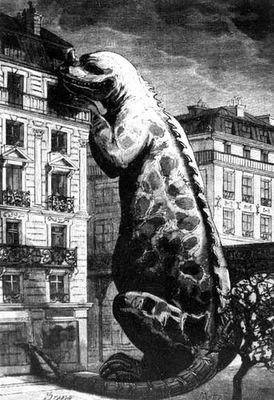
American Scientist Picture -- This illustration from Camille Flammarion’s Le Monde avant la Création de l'Homme (1886) was the first to show a dinosaur (Iguanaodon) in a theatrical, artificial pose.
The American Scientist has a fascinating article on the cultural history of dinosaurs.
Why is it that dinosaurs are so popular -- more so than other, equally interesting, scientific enterprises? There have been various psychological explanations offered, but Keith Stewart Thomson, author of the article proposes another. He writes:
Right from the beginning some dinosaur sleuths promoted their discoveries (and themselves) in ways that other fossil hunters did not (or could not). The anatomist Richard Owen, for example, featured them in a display at Britain's Great Exhibition of 1851. For this event, sculptor and master promoter Waterhouse Hawkins created life-sized reconstructions of dinosaurs, which were later removed to a permanent site in South London. Hawkins's famous dinner party inside a half-built Iguanodon moved paleontology a long way towards its modern cultural status.I would point out that archaeologists did much the same. Public relations was the name of the game from the first expeditions on. Both "sciences" offered an exotic glimpse into the past and constructed elaborate fantasies for the public. But, as Thomson recognises,
Granting the extraordinary marketing and publicity that surrounds dinosaurs , it remains true that unless they were fundamentally interesting, such efforts would surely have fizzled out by now.It is hard to argue that the intrinsic interest of paleontology is much greater than that of other branches of science. It is also hard to argue that much of practical value can be gained from the paleontological enterprise. Yet it, like archaeology, has held a place of prominence in the public imagination far greater than it warrants. Is this largely the result of successful long-running publicity campaigns? It's something worth considering.
Read the article here.
No comments:
Post a Comment